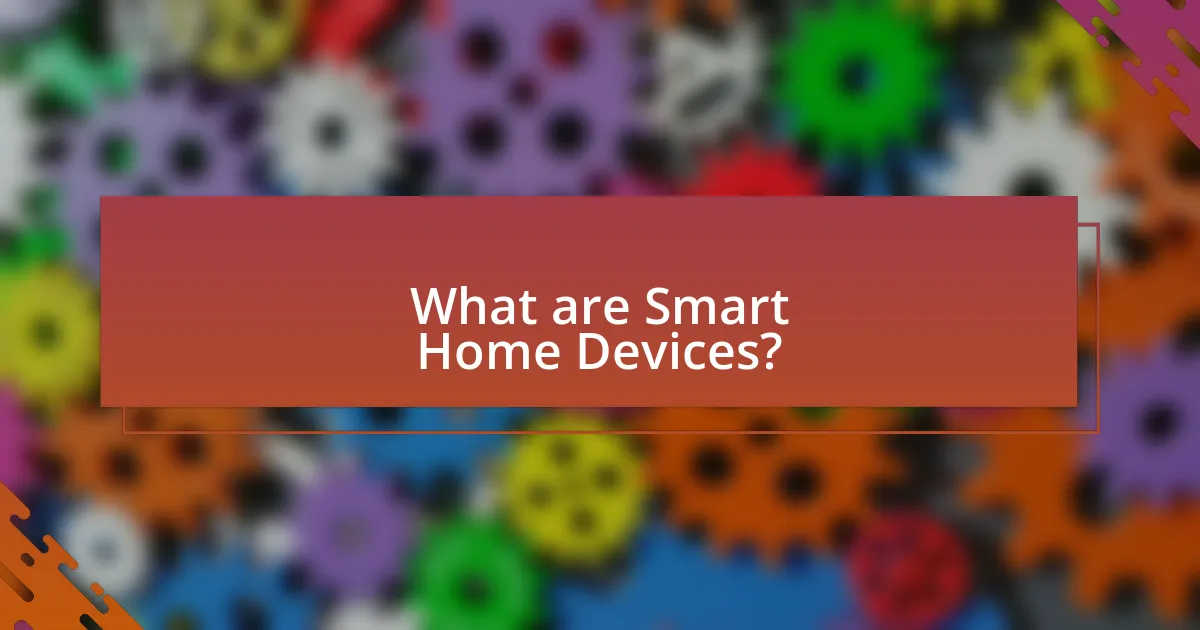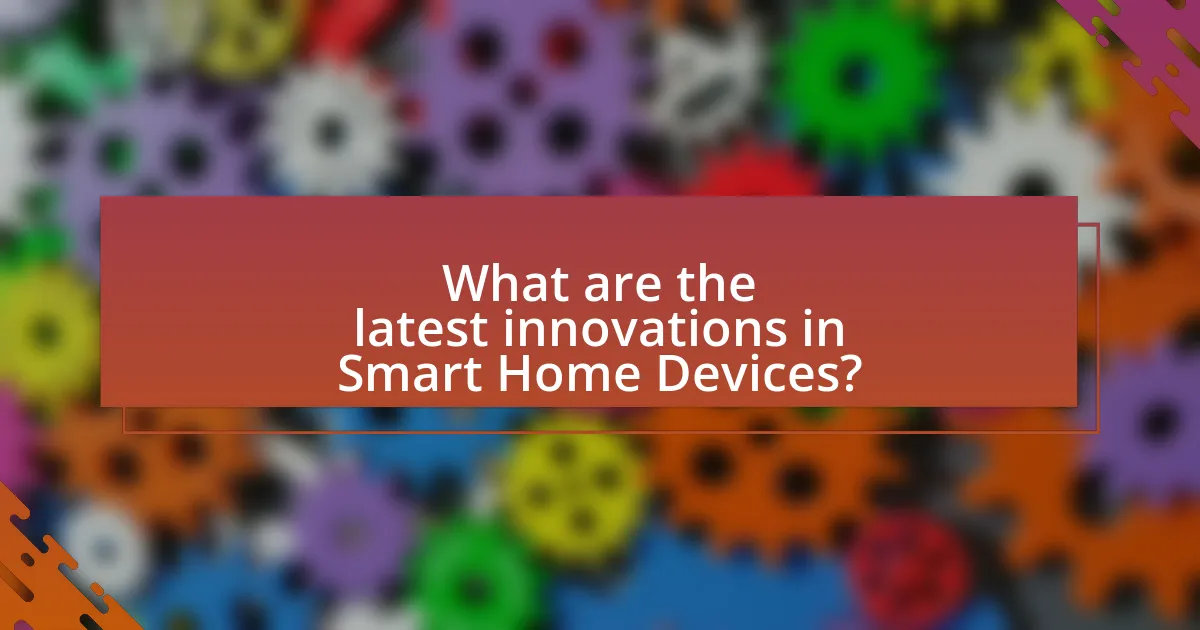Smart home devices are electronic gadgets that connect to a network, enabling remote control and automation of household functions, such as lighting, security, and climate control. This article explores the functionality, technologies, and categories of smart home devices, highlighting their benefits in terms of convenience, energy efficiency, and security. It also discusses the latest innovations, including AI integration and interoperability advancements, while providing practical guidance on implementing these devices effectively in living spaces. Key considerations for choosing and optimizing smart home devices are also addressed, ensuring users can enhance their home environments efficiently and securely.

What are Smart Home Devices?
Smart home devices are electronic gadgets that connect to a network, allowing users to control and automate household functions remotely. These devices include smart thermostats, smart lights, security cameras, and smart speakers, which enhance convenience, security, and energy efficiency in homes. According to a report by Statista, the global smart home market is projected to reach over $135 billion by 2025, indicating a significant trend towards the adoption of these technologies in everyday living.
How do Smart Home Devices function?
Smart home devices function by utilizing a combination of sensors, software, and connectivity to automate and control various household tasks. These devices connect to a central hub or directly to the internet, allowing users to manage them remotely through smartphones or voice-activated assistants. For instance, smart thermostats adjust heating and cooling based on user preferences and occupancy patterns, while smart lights can be programmed to turn on or off at specific times or in response to motion detection. The integration of Internet of Things (IoT) technology enables seamless communication between devices, enhancing convenience and energy efficiency in the home.
What technologies are used in Smart Home Devices?
Smart home devices utilize various technologies including Internet of Things (IoT), wireless communication protocols like Wi-Fi, Zigbee, and Z-Wave, as well as artificial intelligence (AI) for automation and control. IoT enables devices to connect and communicate over the internet, allowing for remote monitoring and management. Wireless protocols facilitate device interconnectivity, ensuring seamless communication between devices. AI enhances user experience by enabling smart assistants to learn preferences and automate tasks, improving efficiency and convenience in home management.
How do Smart Home Devices communicate with each other?
Smart home devices communicate with each other primarily through wireless protocols such as Wi-Fi, Zigbee, Z-Wave, and Bluetooth. These protocols enable devices to send and receive data, allowing for coordinated actions and automation within a smart home ecosystem. For instance, Zigbee and Z-Wave are specifically designed for low-power, short-range communication, making them ideal for connecting various smart devices like lights, sensors, and locks. Wi-Fi, on the other hand, provides higher bandwidth for devices that require more data, such as cameras and streaming devices. The interoperability of these protocols is often facilitated by a central hub or smart assistant, which manages communication and integration among different devices, ensuring seamless operation and user control.
What are the main categories of Smart Home Devices?
The main categories of Smart Home Devices include security systems, lighting controls, climate control, home entertainment, and smart appliances. Security systems encompass devices like smart cameras and doorbells that enhance home safety. Lighting controls allow users to manage lighting remotely or through automation. Climate control devices, such as smart thermostats, optimize energy usage and comfort. Home entertainment devices include smart speakers and streaming devices that enhance media consumption. Smart appliances, like refrigerators and washing machines, offer connectivity and automation for everyday tasks. These categories collectively represent the diverse functionalities of smart home technology, improving convenience and efficiency in modern living spaces.
What are the different types of Smart Lighting solutions?
Smart lighting solutions can be categorized into several types, including smart bulbs, smart switches, smart fixtures, and smart lighting systems. Smart bulbs, such as Philips Hue and LIFX, allow users to control brightness and color through mobile apps or voice commands. Smart switches enable traditional lighting fixtures to be controlled remotely, integrating with home automation systems. Smart fixtures, like integrated LED lights, come with built-in smart technology for direct control. Lastly, smart lighting systems, such as those offered by Lutron and Google Nest, provide comprehensive control over multiple lighting sources, often incorporating sensors and automation features for enhanced energy efficiency and convenience.
How do Smart Thermostats improve energy efficiency?
Smart thermostats improve energy efficiency by automatically adjusting heating and cooling settings based on user behavior and preferences. These devices utilize algorithms and sensors to learn patterns, allowing them to optimize energy use by reducing unnecessary heating or cooling when spaces are unoccupied. For instance, studies indicate that smart thermostats can reduce energy consumption by up to 10-15% annually, translating to significant cost savings on utility bills. Additionally, features like remote access and integration with other smart home devices enable users to monitor and control their energy usage more effectively, further enhancing overall efficiency.
What benefits do Smart Home Devices provide?
Smart home devices provide enhanced convenience, energy efficiency, and improved security for users. These devices allow homeowners to control various aspects of their living environment remotely, such as lighting, temperature, and security systems, often through a smartphone app or voice commands. For instance, a study by the Consumer Technology Association found that 70% of smart home device owners reported increased convenience in their daily routines. Additionally, smart thermostats can reduce energy consumption by up to 15%, leading to significant cost savings on utility bills. Furthermore, smart security systems offer real-time monitoring and alerts, which can reduce the likelihood of break-ins by up to 300%, according to the Electronic Security Association.
How do Smart Home Devices enhance security?
Smart home devices enhance security by providing real-time monitoring, automated alerts, and remote access control. These devices, such as smart cameras, doorbell cameras, and smart locks, allow homeowners to monitor their property from anywhere via mobile applications. For instance, smart cameras can send instant notifications to users when motion is detected, enabling prompt responses to potential threats. According to a study by the Security Industry Association, homes equipped with smart security devices experience a 300% increase in security effectiveness compared to those without. This integration of technology not only deters intruders but also provides homeowners with peace of mind through constant surveillance and control over their security systems.
What impact do Smart Home Devices have on convenience and comfort?
Smart home devices significantly enhance convenience and comfort by automating daily tasks and providing remote control over home systems. For instance, smart thermostats can learn user preferences and adjust temperatures accordingly, leading to energy savings and increased comfort. A study by the Consumer Technology Association found that 70% of smart home device users reported improved convenience in their daily routines. Additionally, smart lighting systems allow users to control lighting remotely or set schedules, further enhancing comfort and ease of use.

What are the latest innovations in Smart Home Devices?
The latest innovations in smart home devices include advanced AI integration, enhanced security features, and improved energy efficiency. For instance, devices like smart thermostats now utilize machine learning algorithms to optimize heating and cooling based on user behavior, resulting in energy savings of up to 30%. Additionally, smart security systems have incorporated facial recognition technology, allowing for real-time alerts and monitoring, significantly increasing home safety. Furthermore, the introduction of smart appliances, such as refrigerators that can track inventory and suggest recipes, showcases the growing trend of interconnected devices that enhance convenience and efficiency in daily living.
How are AI and machine learning transforming Smart Home Devices?
AI and machine learning are transforming smart home devices by enabling them to learn user preferences and automate tasks for enhanced convenience and efficiency. For instance, smart thermostats like Nest utilize machine learning algorithms to analyze user behavior and optimize heating and cooling schedules, resulting in energy savings of up to 15% according to the U.S. Department of Energy. Additionally, AI-powered voice assistants, such as Amazon Alexa and Google Assistant, improve user interaction by understanding natural language and context, allowing for seamless control of various smart devices. This integration of AI and machine learning not only enhances user experience but also increases the functionality and adaptability of smart home systems.
What role does voice recognition play in Smart Home technology?
Voice recognition serves as a critical interface in Smart Home technology, enabling users to control devices through spoken commands. This technology enhances user convenience and accessibility, allowing for hands-free operation of various smart devices such as lights, thermostats, and security systems. According to a report by Statista, the global smart speaker market is projected to reach 35 million units by 2025, indicating a growing reliance on voice-activated systems in home automation. This trend underscores the importance of voice recognition in facilitating seamless interactions between users and their smart home environments.
How do Smart Home Devices integrate with IoT ecosystems?
Smart home devices integrate with IoT ecosystems by utilizing standardized communication protocols, enabling seamless interaction and data exchange among various devices. These devices, such as smart thermostats, lights, and security cameras, connect to a central hub or cloud service, allowing users to control them remotely via smartphones or voice assistants. For instance, devices that support Zigbee or Z-Wave protocols can communicate with each other and with the hub, creating a cohesive smart home environment. This integration enhances automation, as users can set routines that trigger multiple devices simultaneously based on specific conditions, such as time of day or occupancy. The effectiveness of this integration is evidenced by the growing adoption of IoT technologies in homes, with a report from Statista indicating that the number of connected smart home devices worldwide is projected to reach 1.3 billion by 2025.
What are the emerging trends in Smart Home technology?
Emerging trends in Smart Home technology include increased integration of artificial intelligence, enhanced security features, and the rise of energy-efficient devices. Artificial intelligence is being utilized to create more intuitive home automation systems that learn user preferences and behaviors, allowing for personalized experiences. Enhanced security features, such as smart locks and surveillance cameras with facial recognition, are becoming standard to protect homes more effectively. Additionally, energy-efficient devices, including smart thermostats and lighting systems, are gaining popularity as homeowners seek to reduce energy consumption and lower utility bills. According to a report by MarketsandMarkets, the smart home market is projected to grow from $80.21 billion in 2022 to $135.3 billion by 2025, indicating a significant shift towards these technologies.
How is sustainability influencing Smart Home Device design?
Sustainability is significantly influencing Smart Home Device design by prioritizing energy efficiency and eco-friendly materials. Manufacturers are increasingly integrating features such as energy monitoring, which allows users to track and reduce their energy consumption, thereby lowering their carbon footprint. For instance, smart thermostats can optimize heating and cooling based on user habits, leading to energy savings of up to 10-15% annually, as reported by the U.S. Department of Energy. Additionally, many smart devices are now constructed from recyclable or sustainable materials, reflecting a commitment to reducing environmental impact. This shift not only meets consumer demand for greener products but also aligns with global sustainability goals, driving innovation in the smart home sector.
What advancements are being made in Smart Home Device interoperability?
Advancements in Smart Home Device interoperability include the development of universal standards such as Matter, which aims to enhance compatibility among devices from different manufacturers. Matter, backed by major companies like Apple, Google, and Amazon, facilitates seamless communication between smart devices, allowing users to control them through a single platform. This standardization reduces fragmentation in the smart home ecosystem, enabling devices to work together more efficiently. Additionally, advancements in cloud-based solutions and AI-driven integration are improving the ability of devices to learn user preferences and automate interactions, further enhancing interoperability.

How can you effectively implement Smart Home Devices in your living space?
To effectively implement Smart Home Devices in your living space, begin by assessing your needs and identifying areas where automation can enhance convenience, security, or energy efficiency. For instance, installing smart lighting can reduce energy consumption by up to 80% compared to traditional bulbs, as reported by the U.S. Department of Energy. Next, ensure compatibility among devices by choosing products that work with a central hub or platform, such as Google Home or Amazon Alexa, which can streamline control and integration. Additionally, prioritize devices that offer user-friendly interfaces and robust security features to protect your network. Finally, regularly update device firmware to maintain security and functionality, as outdated software can expose vulnerabilities.
What factors should you consider when choosing Smart Home Devices?
When choosing smart home devices, consider compatibility, security, ease of use, and functionality. Compatibility ensures that devices can communicate with each other and integrate into your existing ecosystem, such as whether they work with platforms like Amazon Alexa or Google Assistant. Security is crucial, as devices can be vulnerable to hacking; look for features like encryption and regular software updates. Ease of use refers to how intuitive the device is to operate, which can significantly affect user experience. Functionality involves assessing whether the device meets your specific needs, such as energy efficiency or automation capabilities. These factors collectively influence the effectiveness and reliability of smart home devices in enhancing your living space.
How do you assess compatibility with existing home systems?
To assess compatibility with existing home systems, one must evaluate the communication protocols and standards used by both the new smart device and the current home systems. For instance, many smart home devices utilize Wi-Fi, Zigbee, or Z-Wave protocols, so confirming that the new device supports the same protocol as the existing systems is crucial. Additionally, checking for compatibility with home automation platforms, such as Google Home or Amazon Alexa, ensures seamless integration. According to a study by the Consumer Technology Association, 70% of consumers reported that compatibility with existing devices significantly influenced their purchasing decisions, highlighting the importance of this assessment.
What budget considerations should you keep in mind?
When budgeting for smart home devices, consider the initial purchase cost, installation expenses, and ongoing maintenance fees. The initial purchase cost varies widely; for example, smart speakers can range from $50 to $400, while smart security systems may start at $200 and go up significantly based on features. Installation expenses can also add up, especially for devices requiring professional setup, which can range from $100 to $500 depending on complexity. Ongoing maintenance fees, such as subscription services for cloud storage or premium features, should also be factored in, as they can add $10 to $30 monthly. Understanding these costs helps in making informed decisions about which smart home devices to invest in.
What are some best practices for setting up Smart Home Devices?
To set up smart home devices effectively, prioritize a strong and secure Wi-Fi network, as most devices rely on internet connectivity for functionality. Ensure that your router is centrally located to provide optimal coverage and consider using a separate network for smart devices to enhance security. Additionally, follow the manufacturer’s instructions for installation and configuration, which often include app-based setup processes that guide users through connecting devices to the network. Regularly update device firmware to protect against vulnerabilities, as manufacturers frequently release updates to enhance security and performance. Finally, organize devices into groups or rooms within the controlling app for easier management and automation, allowing for streamlined control and enhanced user experience.
How can you ensure a secure Smart Home network?
To ensure a secure Smart Home network, implement strong, unique passwords for all devices and regularly update firmware. Strong passwords reduce the risk of unauthorized access, while firmware updates often include security patches that protect against vulnerabilities. According to a study by the Cybersecurity & Infrastructure Security Agency, 85% of successful cyberattacks exploit known vulnerabilities, emphasizing the importance of keeping devices updated. Additionally, segmenting the Smart Home network from other personal devices can further enhance security by limiting access points for potential intruders.
What tips can help optimize the performance of Smart Home Devices?
To optimize the performance of smart home devices, ensure they are connected to a strong and stable Wi-Fi network. A robust Wi-Fi connection minimizes latency and enhances responsiveness, which is critical for devices like smart speakers and security cameras. Additionally, regularly updating the firmware of these devices can improve functionality and security, as manufacturers often release updates that fix bugs and enhance performance. Furthermore, strategically placing devices within range of the router can reduce signal interference, thereby improving connectivity. Lastly, utilizing a smart home hub can streamline communication between devices, allowing for more efficient operation and automation.
What common troubleshooting tips can help with Smart Home Devices?
Common troubleshooting tips for Smart Home Devices include checking the power supply, ensuring a stable Wi-Fi connection, and restarting the device. Verifying that the device is properly connected to the network can resolve connectivity issues, as many smart devices rely on Wi-Fi for functionality. Restarting the device can clear temporary glitches, while checking the power supply ensures that the device is receiving adequate power. Additionally, updating the device’s firmware can fix bugs and improve performance, as manufacturers often release updates to enhance functionality and security.



